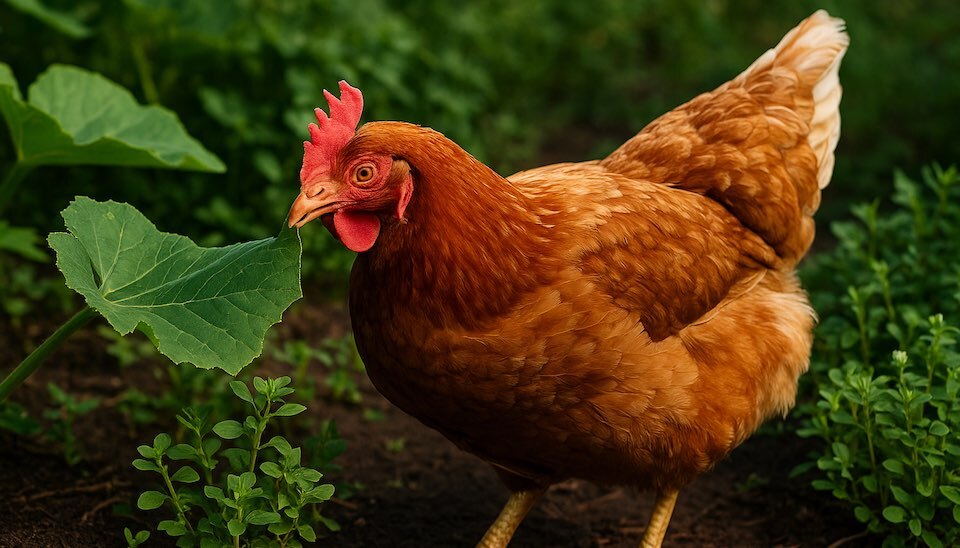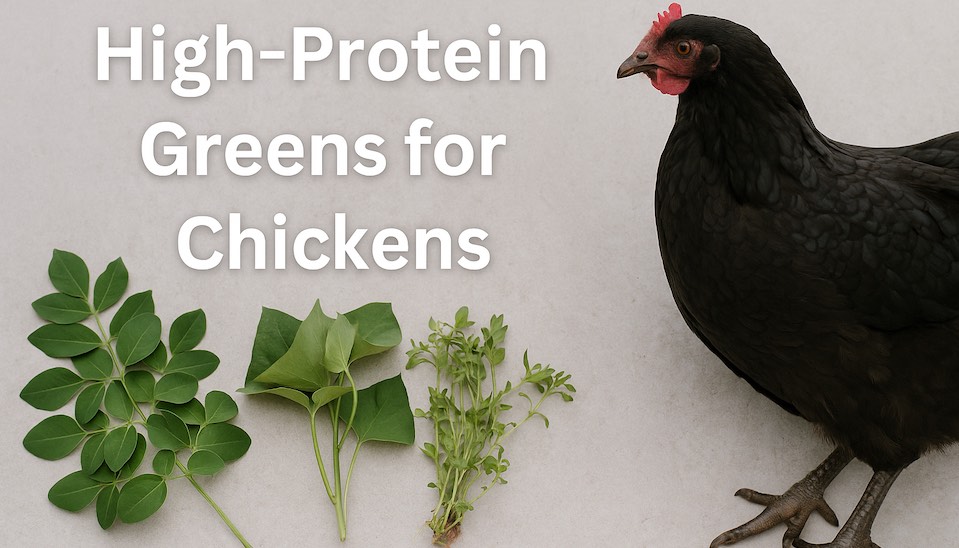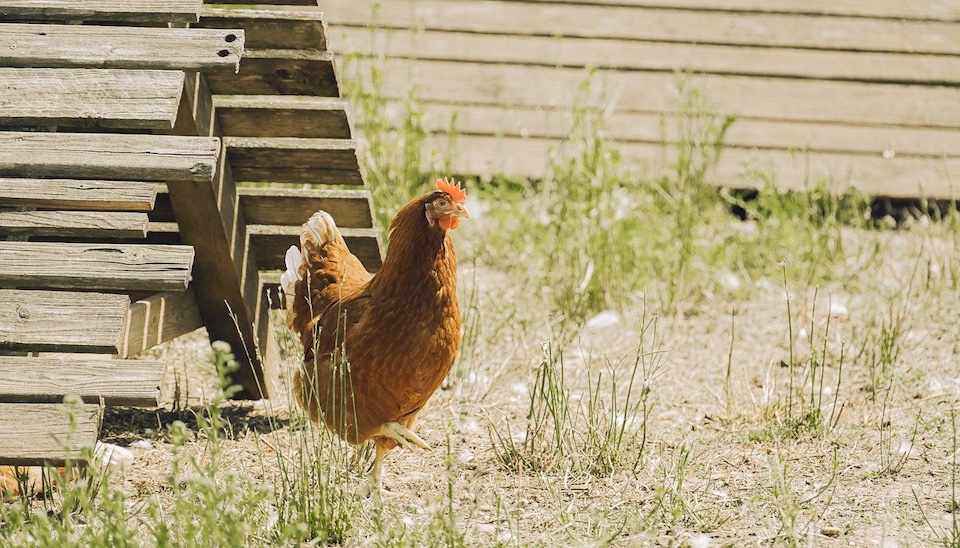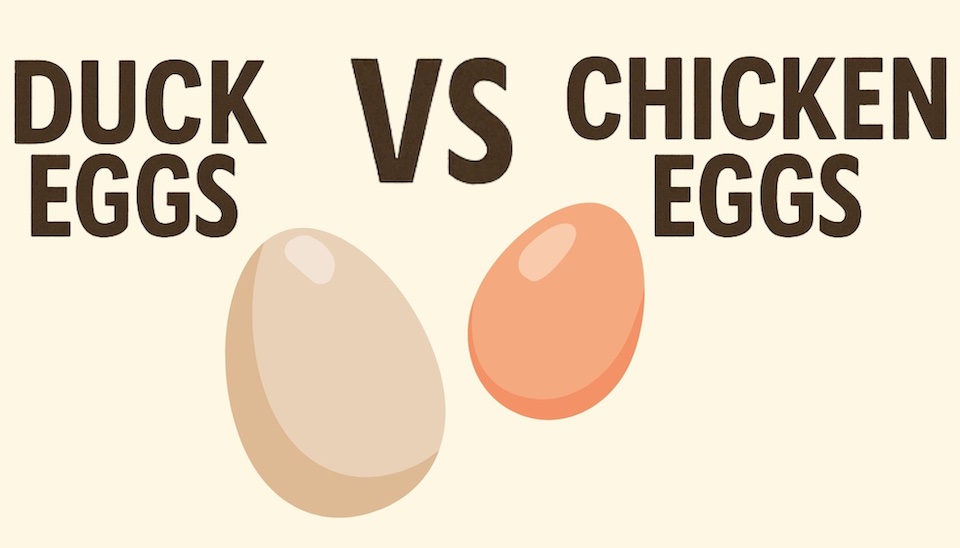Top 10 High-Protein Chicken Forage Greens To Grow At Home
Boost Protein with High-Protein Greens for Chickens
Protein is essential for healthy, productive hens. Without enough protein, egg production decreases and chickens can also engage in feather pecking or cannibalism to try to meet their protein needs.
Laying hens often have a protein deficiency due to poor diet or free-ranging. Choosing a high-protein pellet or mash feed and adding high-protein forage to the diet can help increase protein to support health and egg production. Read on for a list of our top 10 high-protein forage greens for chickens that you can grow at home.
Key takeaways
- Laying hens need 16-18 % dietary protein to stay healthy and maintain egg production
- Grain mixes, scraps and free-ranging decrease protein intake leading to deficiencies
- Choosing a high-protein pellet or mash and providing high-protein treats like Dried Insects and high-protein forage can help prevent deficiencies
- Protein-rich forage includes moringa, lucerne and tagaste, along with common garden plants like pumpkin vines and sweet potato leaves
- Forage plants will need protection from chickens at least until they are established
The cause of protein deficiency in chickens
In order to produce eggs and remain healthy, laying hens need 16-18 % protein in their diet. Most complete chicken feeds fall in this range. So why is protein deficiency so common in backyard flocks?
The top 3 causes of protein deficiency in laying hens are:
- Grain mixes
Too many backyard chicken keepers still choose a grain mix for their hens. Often, this is on the advice of the feed store! However, even a “complete” grain mix, which will usually contain the addition of pellets to boost protein and other nutrients, typically causes deficiencies.
This is because a grain mix encourages selective feeding. Have you ever seen certain seeds left in the bottom of the Feeder? When chickens can see the different ingredients in their feed, they will eat the tastiest bits first. But favourites like sunflower seeds and corn are not the most nutritious!
By neglecting the pellets and certain other ingredients, chickens are not eating a complete diet, even when they are given a complete feed. They rarely consume enough protein to meet their daily requirements.
This is why a pellet or mash feed is by far the best choice for chickens. Chicken keepers sometimes complain that their birds don’t like pellets or won’t eat them, and this can be true of birds that are used to having a grain mix. However, if you provide only pellets or mash, chickens will learn to eat them.
- Free-ranging
There are many benefits to allowing chickens to free-range. But the fact is, free-ranging is associated with protein deficiencies in backyard laying hens.
In theory, free-ranging should provide protein-rich insects. In reality, free-range hens consume mostly forage and seeds. There is very little insect protein unless chickens are moved onto fresh pasture every day or so. If your chickens free-range in the same area day-after-day, you can safely assume they have wiped out most tasty insects and are not getting much protein from their foraging at all. In addition, they consume less chicken feed due to the foraged food, diluting the protein available through the feed.
This is not to say that hens shouldn’t free-range. Foraging provides a wide-range of nutrients, and there are behavioural benefits to allowing chickens to free-range. But for free-range laying hens, it can be wise to provide additional protein, via a high-protein feed (e.g. 20 % protein) or regular treats like Dried Mealworms or high-protein greens, in order to ensure their needs are being met.
- Too many scraps
Like free-ranging, scraps dilute the nutrient content in the diet. If chickens are eating scraps, they are eating less of their complete feed. If the scraps don’t have the same nutritional benefits as the feed, chickens will end up with deficiencies.
Common scraps like bread, pasta and rice are high in energy but contain little protein. Vegetable and fruit scraps, which are much healthier for chickens, have lots of fibre and vitamins, but again little protein.
If your chickens have signs of protein deficiency, it is best to cut scraps out of their diet completely. But if you are feeding your chickens scraps, do so late in the day and give them no more than they can eat in 20 minutes. This will ensure the majority of their diet is still their feed.
How to boost protein for chickens
There are many ways to boost protein for chickens, and this is something all free-range chicken keepers should be doing.
First, make sure you are providing a high-protein complete feed as a pellet or mash. Most chicken feed contains between 15 and 20 % protein, so opt for one of the higher protein options.
Insects, such as Dried Black Soldier Fly Larvae and Dried Mealworms, also make an excellent protein supplement and can be used as a regular treat for chickens.
Another really great way to boost protein, that is also easy on the hip-pocket, is growing high-protein green for your girls.
10 high-protein forage greens for chickens
Most green forage is relatively low in protein. But some plants have high protein in the leaves. Providing these high-protein plants as forage greens for your chickens can be a great way to increase protein in the diet.
It is important to note that while high-protein forage is beneficial for chickens, it is not a replacement for a complete chicken feed and should not constitute more than 10 % of the diet. In general, high-protein forage should be given free-choice in small amounts, like other additions to the diet.

Here is a list of our top 10 high-protein forage greens for chickens:
-
Moringa (Moringa oleifera)
38 % protein
Moringa is a fast-growing tree that can become very large, although regular pruning can keep it at a manageable size. It grows in warm climates, including the tropics, subtropics and semi-arid areas. It copes well with poor soil and little rain, but will not tolerate frosts. In cooler climates, it is deciduous.
The Moringa tree is also called the “miracle tree” because all parts of the plant are edible. Scientific studies usually link moringa leaves, again dried, to improved performance and health for chickens.
-
Papaya (Carica papaya)
26 % protein
Papaya is another tree for tropical and subtropical regions. They can be grown in more arid climates, as long as temperatures are warm year-round, but need regular water. Papaya does not cope with drought or frosts.
-
River tamarind (Leuceana leucocephal)
25 % protein
This is an invasive plant that is regarded as an environmental weed in most states and territories. While it shouldn’t be planted, if you have access to the weed and know it is spray-free, it is a great forage green to harvest for chickens.
-
Tree lucerne or tagaste (Chamaecytisus palmensis)
20-24 % protein
This slow-growing, evergreen tree is suited to a range of climates. It prefers temperate and Mediterranean climates, and does not cope with water-logged, heavy soils. It is very drought-tolerant and can cope with cold winters. Very hot summers, high rainfall and coastal conditions may pose a problem.
Tagaste provides excellent forage for chickens and the drooping branches will also provide good summer shade.
-
Lucerne or alfalfa (Medicago sativa)
12-24 % protein
Lucerne is a bushy plant, growing up to a metre. It grows best in temperate areas with moderate rainfall. It can cope with dry conditions, particularly once established, but struggles with water-logging and high humidity.
Lucerne provides excellent forage for chickens. The plant is adapted for regular harvesting and will re-shoot from the crown for many years once it is established.
-
Pigeon pea (Cajanus cajun)
9-22 % protein
This bushy legume is exceptionally easy to grow and suits tropical and subtropical climates, although it can cope with some drought. Pigeon pea can be grown in cooler areas, although frosts will kill it. Because it is so fast-growing, pigeon pea is suitable for planting as an annual, although it will live up to 5 years and grow to several meters in ideal conditions.
Pigeon pea leaves are a preferred fodder for chickens along with livestock such as cattle and goats.
-
Wattle (Acacia spp.)
Protein content varies by species, typically 14-18 %
There are wattle species of all types and suited to all climates. The best approach is to ask a native plant nursery for a species that is edible, local to your area and suitable for your space and soil type.
It is important to note that not all wattle species are edible and some are poisonous. But the varieties that are safe make great forage for chickens, with edible leaves and seeds.
-
Sweet potato (Ipomoea batata)
10-12 % protein
Sweet potato is a crawling vine that makes a hardy ground cover. It grows year-round in subtropical and tropical areas. In cooler climates, it will grow in frost-free months.
While most studies look at the benefits of dried sweet potato leaves as a chicken feed, raw leaves are still protein-rich, safe for chickens and much easier to provide on a backyard scale.
-
Pumpkin leaves
7-12.5 % protein
There are pumpkin varieties for all climates, and any type of pumpkin vine will make good forage for chickens. All garden varieties are edible.
Pumpkin leaves and vines have a surprising amount of protein and can be fed to chickens, who will happily eat the pumpkins too!
-
Chickweed
14-20 % protein
Chickweed grows in moist, rich soil and is a common garden weed found throughout Australia. It tends to grow in the cooler months, in shaded areas such as under trees or plants. While you may be able to find chickweed growing naturally in your garden, you can also purchase seeds from some specialty seed companies.
Chickens will happily eat chickweed when they come across it. But if you are harvesting the green for your chickens, ensure you have identified it correctly. If the stem oozes white milk, it is not chickweed and is best disposed of!
Tips for growing high-protein forage greens for chickens
Chickens can be pretty destructive in a garden – scratching and constant foraging can quickly kill even established plants, while new seedlings haven’t a hope!
Many chicken keepers who grow forage for their hens grow the plants in a garden, and simply cut forage for their hens as needed. Plants are easy to tend and can re-grow between harvests.
Another option is to plant forage greens just outside of the chicken coop or run, so that chickens can eat greens that grow through the fence but the plant itself is protected. For an in-run option, a raised garden bed with chicken wire over the top can be used to protect plants from scratching and allow chickens to eat the plants as they grow tall enough to poke through the wire mesh.
For trees, like moringa and tagaste, it is also possible to grow the tree in the chicken run. Once it is well-established and large enough, chickens can forage without damaging the plant. However, for most trees it will take several years, at least, before they can withstand the constant onslaught of foraging chickens! Bird netting or chicken wire can be used to make a semi-permanent enclosure to protect trees while they become established.
Conclusions
Protein is one of the most important nutrients for egg production. Even when hens have free access to a complete feed, protein deficiencies are still common, particularly in free-range flocks. Choosing a high-protein pellet or mash feed and offering natural protein supplements like Dried Insects and high-protein forage greens can ensure your chickens have the protein they need to thrive.
Do you want to learn more about protein for laying hens? Check out these other articles on the blog:
Happy chicken keeping!
Rachael at Dine-A-Chook Australia



